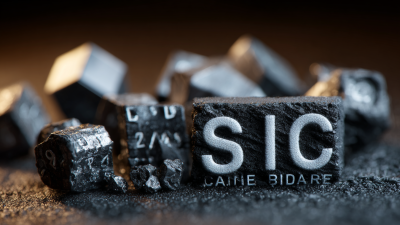Leave Your Message
The advancement of electronics in the 21st century is heavily reliant on innovative materials, and Sic Silicon Carbide stands at the forefront of this evolution. As highlighted in the latest report by MarketsandMarkets, the global SiC market is projected to grow from $1.82 billion in 2020 to $4.24 billion by 2025, reflecting a remarkable compound annual growth rate (CAGR) of 18.5%. This growth is driven by the increasing demand for power electronics, particularly in electric vehicles (EVs) and renewable energy applications, where efficiency and thermal conductivity are paramount.

Experts agree on the transformative potential of Sic Silicon Carbide. Dr. John Cheng, a leading researcher in power semiconductors, emphasizes this potential by stating, "SiC technology not only enhances the performance of electronic devices but also contributes significantly to energy savings and sustainability in various applications." His insights underline the critical role SiC plays in enabling the next generation of electronics, which require materials that can withstand higher temperatures and voltages while maintaining efficiency.
In this context, our exploration of the Top 10 applications and advantages of Sic Silicon Carbide will provide a comprehensive understanding of how this compound is shaping the future of electronics, promoting innovation and paving the way for more sustainable technological solutions.
Silicon Carbide (SiC) emerges as a transformative material in high-efficiency power electronics, boasting exceptional properties like high power density, thermal stability, and energy efficiency. These attributes make SiC particularly well-suited for applications in electric vehicles, 5G communications, and smart grids. With the ongoing advancements in SiC technology, its capabilities in power conversion and high-voltage performance are being increasingly recognized, paving the way for next-generation electronics that prioritize efficiency and sustainability.
Tips: When considering SiC for power electronics, it’s crucial to evaluate the specific application requirements, including voltage thresholds and thermal management. Integrating SiC devices can lead to significant improvements in system efficiency, which is vital for achieving energy-saving goals and reducing carbon emissions in industrial practices.
As the SiC industry progresses towards larger-scale production, such as the strategic shift to 8-inch wafers, the cost-effectiveness and accessibility of SiC technology will continue to improve. This evolution promises to unlock even greater potential in high-efficiency power electronics, making SiC a pillar of the future energy landscape.
Silicon carbide (SiC) is rapidly emerging as a critical material for next-generation electronics, particularly in applications requiring high performance, efficiency, and thermal stability. One of the most significant applications is in power devices, where SiC enables faster switching, reduced losses, and improved thermal management. This makes it ideal for use in electric vehicles (EVs), renewable energy systems, and industrial applications, where efficiency and reliability are paramount.
In high-frequency applications, SiC plays a vital role in RF and microwave devices. Its superior thermal conductivity and electric field strength allow for smaller and more efficient components, making it a preferred choice for 5G technology and advanced communication systems. The miniaturization of components not only adds to the performance but also reduces the overall size of electronic devices, paving the way for more compact and powerful systems.
Tips: Consider the specific requirements of your application when choosing SiC components. Evaluate factors like voltage ratings, thermal dissipation, and switching speeds to maximize efficiency. Additionally, staying updated on the latest developments in SiC technology can provide insights into emerging applications and innovations that could benefit your projects. Look for partnerships with suppliers who specialize in SiC solutions for tailored support and guidance.
Silicon carbide (SiC) is increasingly being recognized for its potential to revolutionize next-generation electronics, particularly in power devices and high-efficiency systems. However, the widespread adoption of SiC technology has been hindered by several challenges, the most significant being manufacturing complexities and cost issues. According to a report by Yole Développement, the SiC power semiconductor market is expected to surpass $2.2 billion by 2025, growing at a CAGR of over 24%. Despite this, high production costs and limitations in supply chain capabilities continue to impede broader utilization.
To overcome these challenges, innovation in manufacturing techniques is essential. Advanced crystal growth techniques, such as liquid-phase epitaxy and high-temperature chemical vapor deposition, have shown promise in reducing defects and improving yield rates. Furthermore, collaboration among industry stakeholders, including material suppliers and semiconductor manufacturers, can streamline supply chains and foster economies of scale. A report by Gartner predicts that as these solutions gain traction, SiC adoption could increase substantially, enabling a new wave of energy-efficient applications in sectors such as automotive and renewable energy. This collaborative effort is crucial for unlocking the full potential of SiC in electronic devices.
| Challenge | Impact | Potential Solutions | Adoption Level |
|---|---|---|---|
| High Production Costs | Limits affordability for consumers | Investment in R&D for cost-effective manufacturing processes | Moderate |
| Material Limitations | Performance constraints in certain applications | Developing hybrid materials combining SiC with other semiconductors | Low |
| Thermal Management Issues | Potential for overheating | Innovations in cooling techniques and thermal interface materials | Moderate |
| Lack of Industry Standards | Inconsistent quality and reliability | Establishment of industry-wide standards and certifications | Low |
| Complex Manufacturing Processes | Increases time to market | Streamlining production lines and automation | Moderate |
Silicon Carbide (SiC) has emerged as a formidable competitor to traditional semiconductor materials like silicon (Si) and gallium nitride (GaN), particularly in the context of next-generation electronics. With its wide band gap properties, SiC offers superior thermal conductivity, high breakdown voltage, and increased efficiency in power applications. These advantages make SiC an ideal candidate for demanding environments that traditional materials struggle to handle, such as electric vehicles, renewable energy systems, and high-frequency communication devices.
Moreover, the SiC wafer market is experiencing significant growth, driven by the rising demand for high-performance electronic devices. The market was valued at over USD 1.15 billion in 2024 and is projected to expand at a compound annual growth rate (CAGR) of 17.03% through 2033. As technologies continue to evolve, manufacturers are increasingly adopting laser-assisted slicing and planarization techniques to enhance the sustainability and efficiency of SiC wafer production, positioning SiC as a critical player in the semiconductor landscape.
This chart illustrates the efficiency percentages of different semiconductor materials used in next-generation electronics. Silicon Carbide (SiC) shows the highest efficiency, making it a promising candidate for advanced electronic applications.
The SiC (silicon carbide) technology is rapidly gaining traction in the electronics sector, presenting significant market opportunities as the demand for advanced semiconductor materials grows. The impressive projected growth of the global LED chip and module market, expected to reach $4.637 billion by 2025 and grow to $6.851 billion by 2033 at a CAGR of 5.0%, is a testament to the increasing relevance of SiC in next-generation applications. SiC's unique properties, such as high thermal conductivity, excellent electrical performance, and remarkable efficiency, position it as a critical component in developing LEDs and other high-performance electronic devices.
As industries continue to focus on energy efficiency and sustainability, the need for efficient power conversion and solid-state lighting solutions will drive innovation in SiC technology. Companies are likely to invest heavily in research and development to enhance the performance and lower the costs associated with SiC devices. Consequently, a fertile landscape for growth in both the production of SiC wafers and the final electronics products integrating this technology is anticipated, creating a myriad of opportunities for market players and paving the way for a new era of electronic innovation.






